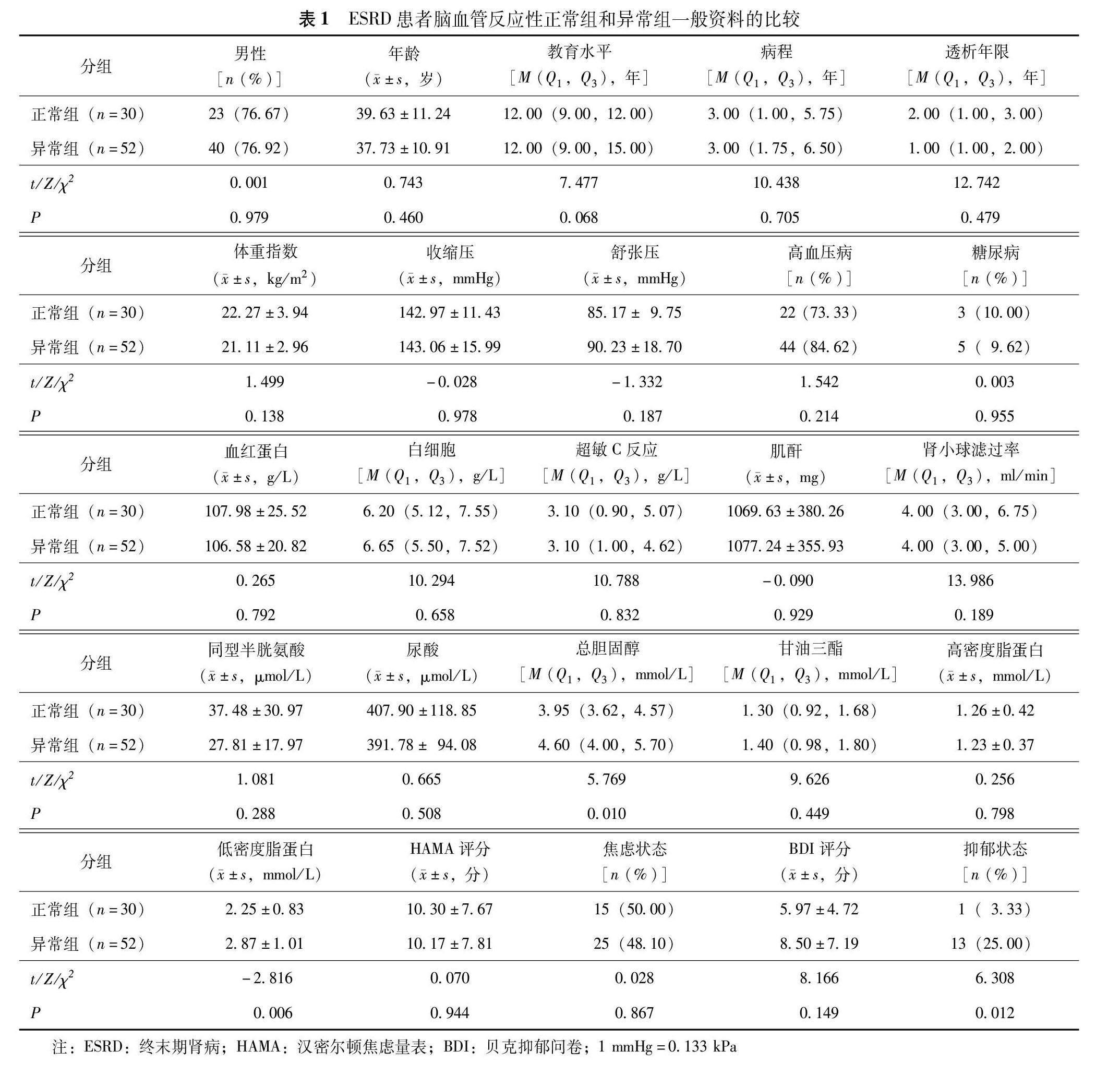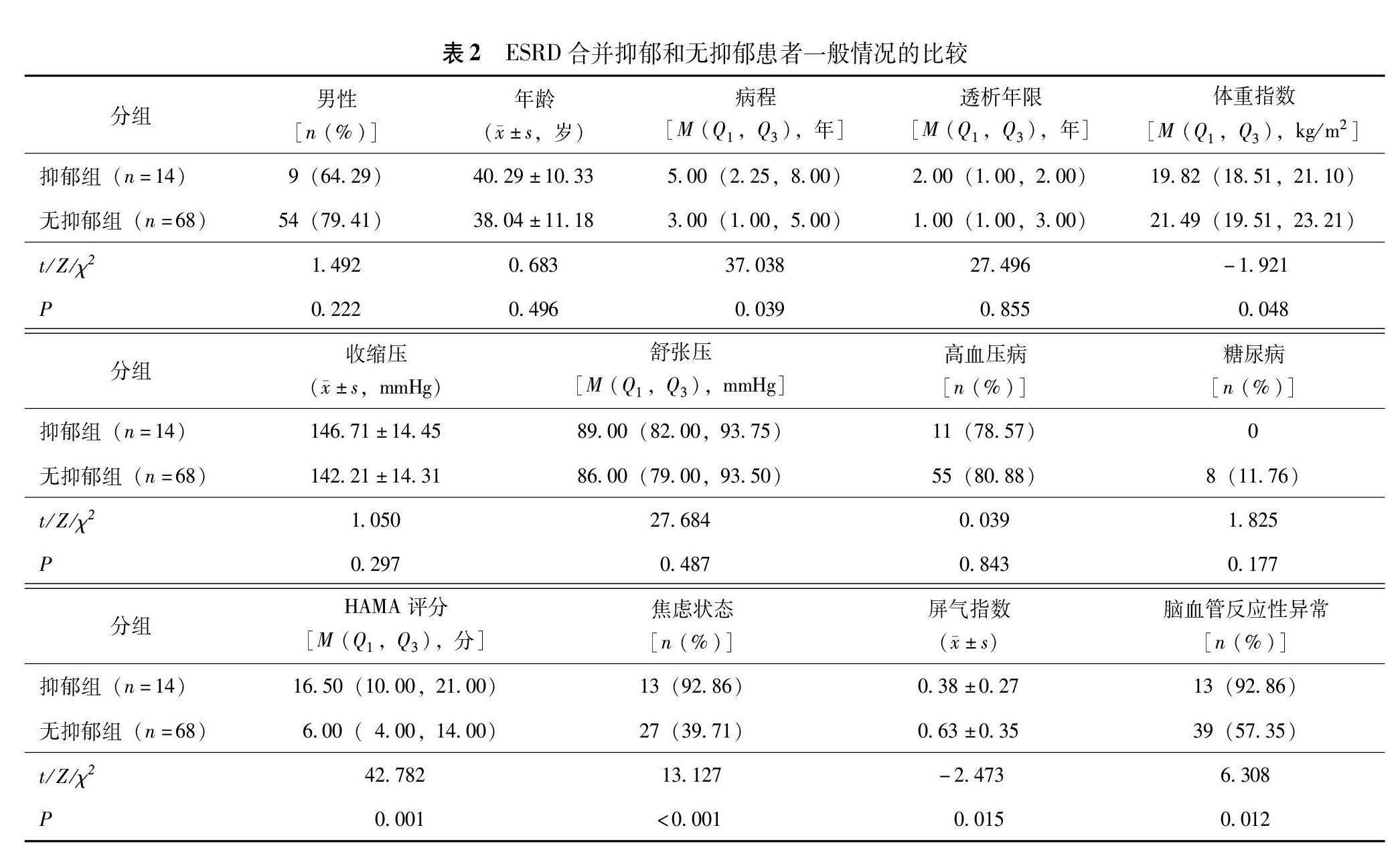终末期肾病患者脑血管反应性与抑郁状态的关系
2024-07-08李姝莹陈睿唐玮婷马晓杰蔡华彬游咏
李姝莹 陈睿 唐玮婷 马晓杰 蔡华彬 游咏


摘要:目的 探讨持续血液透析的终末期肾病(ESRD)患者脑血管反应性(CVR)与情绪障碍的关系。方法 收集持续血液透析ERSD患者的临床资料,采用汉密尔顿焦虑量表(HAMA)和贝克抑郁问卷评估患者焦虑和抑郁状态,采用经颅多普勒超声监测屏气试验时脑血流动力学变化,并计算屏气指数。屏气指数≥0.69为 CVR 正常,屏气指数<0.69为 CVR 异常。采用二元Logistic回归分析影响ESRD患者抑郁状态的因素。结果 CVR异常组总胆固醇(P=0.010)、低密度脂蛋白水平(P=0.006)和抑郁状态发生率(P=0.012)高于正常组。抑郁组较无抑郁组的病程更长(P=0.039)、体重指数更低(P=0.048)、HAMA评分更高(P=0.001)、焦虑状态发生率更高(P<0.001)、屏气指数更低(P=0.015)、CVR异常发生率更高(P=0.012)。二元Logistic回归分析显示焦虑(OR=22.915,95%CI=2.653~197.956,P=0.004)和CVR异常(OR=0.074,95%CI=0.008~0.730,P=0.026)是抑郁状态发生的危险因素。 结论 CVR异常可能是ESRD患者发生抑郁状态的危险因素。
关键词:终末期肾病;脑血管反应性;抑郁;焦虑;经颅多普勒超声
中图分类号: R741 文献标识码: A 文章编号:1000-503X(2024)03-0348-06
DOI:10.3881/j.issn.1000-503X.15891
Relationship Between Cerebrovascular Reactivity and Depression in Patients With End-Stage Renal Disease
LI Shuying CHEN Rui2,TANG Weiting MA Xiaojie3,CAI Huabin4,YOU Yong1
1Department of Neurology,The Second Affiliated Hospital of Hainan Medical University,Haikou 570100,China
2Health Care Center,Hainan General Hospital,Haikou 57031 China
3Department of Rehabilitation Therapy,The Second Affiliated Hospital of Hainan Medical University,Haikou 570100,China
4Department of Neurology,Maoming Peoples Hospital,Maoming,Guangdong 525000,China
Corresponding author:YOU Yong Tel:18976991618,E-mail:youyong@hainmc.edu.cn
ABSTRACT:Objective To investigate the relationship between cerebrovascular reactivity (CVR) and emotional disorders in the patients undergoing continuous hemodialysis for end-stage renal disease (ESRD).Methods The clinical data of the ESRD patients undergoing continuous hemodialysis were collected.Anxiety and depression of the patients were assessed by the Hamilton anxiety scale (HAMA) and Beck depression inventory,respectively.The cerebral hemodynamic changes during the breath holding test were monitored by transcranial Doppler sonography,and the breath-holding index (BHI) was calculated.The BHI≥0.69 and BHI<0.69 indicate normal CVR and abnormal CVR,respectively.Binary Logistic regression was employed to analyze the factors affecting the depressive state of ESRD patients.Results The group with abnormal CVR exhibited higher total cholesterol level (P=0.010),low density lipoprotein level (P=0.006),and incidence of depression (P=0.012) than the group with normal CVR.Compared with the non-depression group,the depression group displayed prolonged disease course (P=0.039),reduced body mass index (P=0.048),elevated HAMA score (P=0.001),increased incidence of anxiety (P<0.001),decreased BHI (P=0.015),and increased incidence of abnormal CVR (P=0.012).Binary Logistic regression analysis indicated anxiety as a contributing factor (OR=22.915,95%CI=2.653-197.956,P=0.004) and abnormal CVR as a risk factor (OR=0.074,95%CI=0.008-0.730,P=0.026) for depression.Conclusion Impaired CVR could pose a risk for depression in the patients with ESRD.
Key words:end-stage renal disease;cerebrovascular reactivity;depression;anxiety;transcranial Doppler sonography
Acta Acad Med Sin,2024,46(3):348-353
慢性肾脏病是一种以肾脏结构或功能长期异常为特征的慢性疾病,已成为危害人类健康的重要公共卫生问题,全球患病率约为13.4%[1]。我国成人慢性肾脏病患病人数达1.32亿,其具有高患病率、高致残率、高医疗花费和低知晓率的特点[2]。 终末期肾病(end-stage renal disease,ESRD)是慢性肾脏病发展的最后阶段,通常只能靠透析或肾移植来维持生命[3]。血液透析作为ESRD患者的主要治疗方法,可明显延长患者的生存时间,但随着疾病进展或治疗时间的延长,患者常会出现焦虑或抑郁等心理健康问题[4-6],并与其生存质量下降和死亡率增高相关[7-8]。ESRD患者发生情绪障碍的确诊率较低,其病理生理机制尚不清楚。研究表明,ESRD患者在血液透析期间可能出现脑血管反应性(cerebral vascular reactivity,CVR)和大脑自动调节功能受损[9-11],增加了脑缺血、脑卒中和亚急性脑水肿等不良事件的发生[12]。CVR是指脑血管对血管活性刺激介质的反应,是反映脑血管储备能力的一项指标[13]。可采用经颅多普勒超声监测屏气试验时的脑血流动力学变化,计算屏气指数来反映CVR水平[14]。CVR受损可能引起脑组织灌注异常,使脑功能受到抑制,是抑郁、焦虑等情绪障碍的潜在影响因素,但持续血液透析的ESRD患者情绪障碍与其CVR的关系尚不明确[15-18]。本研究拟探讨持续血液透析的ESRD患者CVR与其情绪障碍的关系,为临床治疗提供科学依据。
1 对象和方法
1.1 对象
连续入组2021年3月至2022年11月海南医学院第二附属医院肾移植科住院的ERSD患者283例,纳入标准:(1)年龄18~60岁;(2)正在进行血液透析治疗的ERSD患者;(3)自愿参加并签署知情同意书。排除标准:(1)既往患脑卒中或其他重大脑疾病(包括但不限于精神分裂症、痴呆、脑肿瘤、创伤性脑损伤、颅内感染或神经退行性疾病);(2)经颅多普勒超声检查提示颞窗透声不良;(3)颈部动脉或颅内动脉狭窄大于50%。最终入组82例患者,其中男63例,女19例。本研究通过海南医学院第二附属医院伦理委员会批准(伦理审查编号:LW2021025),所有患者均签署知情同意书。
1.2 方法
收集患者一般资料,包括性别、年龄、体重指数、病程、血液透析年限、收缩压、舒张压、高血压病史、糖尿病史、血红蛋白、白细胞、超敏C反应蛋白、肌酐、肾小球滤过率、尿酸、总胆固醇、甘油三酯、高密度脂蛋白、低密度脂蛋白、同型半胱氨酸等。采用汉密尔顿焦虑量表(Hamilton anxiety scale,HAMA)评估患者焦虑状态,HAMA评分≤7分为没有焦虑症状,HAMA评分>7分为有焦虑症状;采用贝克抑郁问卷(Beck depression inventory,BDI)评估患者抑郁状态,BDI评分≤13分为无抑郁症状,BDI评分>13分为有抑郁症状。采用经颅多普勒超声血流分析仪TCD-2000S(北京悦琦创通科技有限公司)及2 MHz超声探头,持续监测并实时记录患者双侧大脑中动脉平均脑血流速度,待血流平稳后嘱患者重复屏气15~30 s两次,并计算屏气指数。屏气指数=(屏气后平均脑血流速度-静息状态平均脑血流速度)/(静息状态平均脑血流速度×屏气秒数)×100。屏气指数≥0.69为CVR正常,屏气指数<0.69为CVR异常[19]。
1.3 统计学处理
采用SPSS 26.0软件,符合正态分布的计量资料以均数±标准差表示,组间比较采用两独立样本t检验;不符合正态分布的计量资料以M(Q Q3)表示,组间比较采用Mann-Whiteny U检验。分类变量以例数(构成比)表示,组间比较采用χ2检验。以是否存在抑郁状态为因变量,对可能有意义的单因素采用二元Logistic回归分析影响抑郁状态的相关因素。P <0.05为差异有统计学意义。
2 结果
2.1 CVR正常组和异常组一般情况的比较
82例患者中,52例(63.41%)出现CVR异常。CVR异常组总胆固醇(P=0.010)、低密度脂蛋白水平(P=0.006)和抑郁状态发生率(P=0.012)高于正常组,而男性、年龄、教育水平、病程、透析年限、体重指数、收缩压、舒张压、高血压病史、糖尿病史、血红蛋白、白细胞、超敏C反应蛋白、肌酐、肾小球滤过率、同型半胱氨酸、尿酸、甘油三酯、高密度脂蛋白、HAMA评分、焦虑状态发生率、BDI评分两组间差异均无统计学意义(P均>0.05)(表1)。
2.2 抑郁组和无抑郁组一般情况的比较
抑郁组较无抑郁组的病程更长(P=0.039)、体重指数更低(P=0.048)、HAMA评分更高(P=0.001)、焦虑状态发生率更高(P<0.001)、屏气指数更低(P=0.015)、CVR异常发生率更高(P=0.012)(表2)。
2.3 二元Logistic回归分析结果
以抑郁状态为因变量,在调整病程、焦虑状态后,将单因素分析中有统计学意义的屏气指数(P=0.039)、焦虑状态(P=0.005)行二元Logistic回归分析,结果显示焦虑(OR=22.915,95%CI=2.653~197.956,P=0.004)和CVR异常(OR=0.074,95%CI=0.008~0.730,P=0.026)是抑郁状态发生的危险因素。
3 讨论
血液透析是ESRD患者的主要治疗方法,本研究结果显示,接受持续血液透析治疗的ESRD 患者中63.41%存在CVR异常,与既往研究结果相近[9-12,17-18,20]。这可能是由于血液透析治疗时患者的动脉压、血浆渗透压、电解质、pH值以及碳酸氢盐等发生较大波动,影响血管舒张能力,从而导致肾病患者CVR和大脑自动调节功能受损[9,20]。
本研究发现CVR异常的ESRD患者总胆固醇和低密度脂蛋白水平高于CVR正常组。既往研究表明高胆固醇可通过引发脑微血管的氧化应激损伤,进而改变血管舒张功能[21-23];而低密度脂蛋白胆固醇氧化形成的氧化低密度脂蛋白可使血管硬化导致CVR受损。因此,脂质代谢紊乱可能是ESRD患者发生CVR受损的原因之一。本研究中92.86%的ESRD合并抑郁患者同时存在焦虑。Malygin等[24]研究也发现焦虑和抑郁存在显著相关性。本研究二元Logistic回归分析提示CVR异常可能是ESRD患者合并抑郁状态的危险因素。这与既往针对抑郁患者的研究结果一致[13,25-26]。抑郁患者存在CVR受损的可能机制包括脑血管内皮功能障碍、小胶质细胞过度活化及细胞因子改变、氧化应激增加和单胺类神经递质紊乱等。脑自动调节功能对于维持脑血流的相对稳定至关重要,脑血流的异常波动可能是脑微血管功能障碍的一种表现[26]。对于ESRD且CVR受损的患者在接受血液透析治疗时,脑血流动力学表现出明显的波动性,透析时动脉压的减低可能导致脑灌注的下降[14],杏仁核等情绪调控相关的脑区发生缺血缺氧损伤,从而影响大脑的情绪管理功能,进而促进ESRD患者抑郁情绪的发生发展[13-16]。
本研究存在一些不足,首先,本研究ESRD患者合并抑郁的样本量较少,这可能导致研究结果的偏倚性,未来需进一步增加样本量来进行更深入的研究;其次,本研究为单中心横断面研究,缺少患者随访数据,未能明确CVR受损与情绪障碍发生的因果关系;最后,ESRD患者伴发抑郁状态是由心理、社会等多种因素共同作用的结果,包括睡眠障碍、脑白质病变、贫血、营养不良、治疗依从性、生活质量下降以及经济压力等等,未来研究需纳入这些因素以验证结果的普适性。
综上,本研究结果表明,CVR受损可能是ESRD患者发生抑郁状态的危险因素,纠正脂质代谢紊乱、维持血液透析时动脉血压稳定或能有效预防CVR受损,有助于降低ESRD患者抑郁情绪的发生风险。
利益冲突 所有作者声明无利益冲突
作者贡献声明 李姝莹:研究设计与实施、撰写论文、对论文进行核修;陈睿:数据搜集、统计学分析、对学术性内容进行修订;唐玮婷、马晓杰、蔡华彬:数据搜集和整理、参与研究设计;游咏:研究指导、论文修改、审阅和定稿
参 考 文 献
[1]Chilcot J,Wellsted D,Da Silva-Gane M,et al.Depression on dialysis[J].Nephron Clin Pract,2008,108(4):c256-c264.DOI:10.1159/000124749.
[2]杨超,张路霞,赵明辉.《中国慢性肾脏病早期评价与管理指南》解读[J].中国实用内科杂志,2023,43(10):839-84 876.DOI:10.19538/j.nk2023100109.
[3]Angermann S,Schier J,Baumann M,et al.Cognitive impairment is associated with mortality in hemodialysis patients[J].J Alzheimers Dis,2018,66(4):1529-1537.DOI:10.3233/JAD-180767.
[4]Al-Jabi SW.Global research trends and mapping knowledge structure of depression in dialysis patients[J].World J Psychiatry,2023,13(8):593-606.DOI:10.5498/wjp.v13.i8.593.
[5]Jeon YH,Lim JH,Jeon Y,et al.The impact of severe depression on the survival of older patients with end-stage kidney disease[J].Kidney Res Clin Pract,2023.DOI:10.23876/j.krcp.22.268.
[6]Qawaqzeh DTA,Masadeh R,Hamaideh SH,et al.Factors affecting the levels of anxiety and depression among patients with end-stage renal disease undergoing hemodialysis[J].Int Urol Nephrol,2023,55(11):2887-2896.DOI:10.1007/s11255-023-03578-1.
[7]Petersen RC,Lopez O,Armstrong MJ,et al.Practice guideline update summary:mild cognitive impairment:report of the guideline development,dissemination,and implementation subcommittee of the American Academy of Neurology[J].Neurology,2018,90(3):126-135.DOI:10.1212/WNL.0000000000004826.
[8]Chaiviboontham S,Phinitkhajorndech N,Tiansaard J.Symptom clusters in patients with end-stage renal disease undergoing hemodialysis[J].Int J Nephrol Renovasc Dis,2020,13:297-305.DOI:10.2147/IJNRD.S2 71619.
[9]Sprick JD,Nocera JR,Hajjar I,et al.Cerebral blood flow regulation in end-stage kidney disease[J].Am J Physiol Renal Physiol,2020,319(5):F782-F791.DOI:10.1152/ajprenal.00438.2020.
[10]Slessarev M,Mahmoud O,Albakr R,et al.Hemodialysis patients have impaired cerebrovascular reactivity to CO2 compared to chronic kidney disease patients and healthy controls:a pilot study[J].Kidney Int Rep,202 6(7):1868-1877.DOI:10.1016/j.ekir.2021.04.005.
[11]Wolfgram DF,Novotny J,Goodman MJ,et al.Risk factors for intradialytic decline in cerebral perfusion and impaired cerebral autoregulation in adults on hemodialysis[J].Hemodial Int,2022,26(1):48-56.DOI:10.1111/hdi.12974.
[12]Masson P,Webster AC,Hong M,et al.Chronic kidney disease and the risk of stroke:a systematic review and meta-analysis[J].Nephrol Dial Transplant,2015,30(7):1162-1169.DOI:10.1093/ndt/gfv009.
[13]Liu P,De Vis JB,Lu H.Cerebrovascular reactivity (CVR) MRI with CO2 challenge:a technical review[J].Neuroimage,2019,187:104-115.DOI:10.1016/j.neuroimage.2018.03.047.
[14]Barrett KM,Ackerman RH,Gahn G,et al.Basilar and middle cerebral artery reserve:a comparative study using transcranial Doppler and breath-holding techniques[J].Stroke,200 32(12):2793-2796.DOI:10.1161/hs1201.098640.
[15]Liu M,He E,Fu X,et al.Cerebral blood flow self-regulation in depression[J].J Affect Disord,2022,302:324-331.DOI:10.1016/j.jad.2022.01.057.
[16]Findlay MD,Dawson J,Dickie DA,et al.Investigating the relationship between cerebral blood flow and cognitive function in hemodialysis patients[J].J Am Soc Nephrol,2019,30(1):147-158.DOI:10.1681/ASN.2018050462.
[17]Chen HJ,Wang YF,Qi R,et al.Altered amygdala resting-state functional connectivity in maintenance hemodialysis end-stage renal disease patients with depressive mood[J].Mol Neurobiol,2017,54(3):2223-2233.DOI:10.1007/s12035-016-9811-8.
[18]Kim SJ,Song SH,Kim JH,et al.Statistical parametric mapping analysis of the relationship between regional cerebral blood flow and symptom clusters of the depressive mood in patients with pre-dialytic chronic kidney disease[J].Ann Nucl Med,2008,22(3):201-206.DOI:10.1007/s12149-007-0108-x.
[19]Castello-Branco RC,Cerqueira-Silva T,Andrade AL,et al.Association between risk of obstructive sleep apnea and cerebrovascular reactivity in stroke patients[J].J Am Heart Assoc,2020,9(6):e015313.DOI:10.1161/JAHA.119.015313.
[20]Richerson WT,Schmit BD,Wolfgram DF.The relationship between cerebrovascular reactivity and cerebral oxygenation during hemodialysis[J].J Am Soc Nephrol,2022,33(8):1602-1612.DOI:10.1681/ASN.2021101353.
[21]Miglinas M,Cesniene U,Janusaite MM,et al.Cerebrovascular disease and cognition in chronic kidney disease patients[J].Front Cardiovasc Med,2020,7:96.DOI:10.3389/fcvm.2020.00096.
[22]Rodrigues SF,Almeida-Paula LD,Granger DN.Synergistic effects of high blood cholesterol and hypertension on leukocyte and platelet recruitment in the cerebral microcirculation[J].Hypertension,2014,63(4):747-752.DOI:10.1161/HYPERTENSIONAHA.113.02627.
[23]Ishikawa M,Stokes KY,Zhang JH,et al.Cerebral microvascular responses to hypercholesterolemia:roles of NADPH oxidase and P-selectin[J].Circ Res,2004,94(2):239-244.DOI:10.1161/01.RES.0000111524.05779.60.
[24]Malygin YV,Orlova AS,Malygin VL.Conceptualization of comorbid anxiety and depressive disorders and approaches to their managing[J].Zh Nevrol Psikhiatr Im S S Korsakova,2022,122(6):48-54.DOI:10.17116/jnevro202212206148.
[25]Zhang W,Fu W,Yan L,et al.Impaired dynamic cerebral autoregulation in young adults with mild depression[J].Psychophysiology,2022,59(1):e13949.DOI:10.1111/psyp.13949.
[26]Darling AM,Richey RE,Akins JD,et al.Cerebrovascular reactivity is blunted in young adults with major depressive disorder:the influence of current depressive symptomology[J].J Affect Disord,202 295:513-521.DOI:10.1016/j.jad.2021.08.061.
(收稿日期:2023-10-19)
